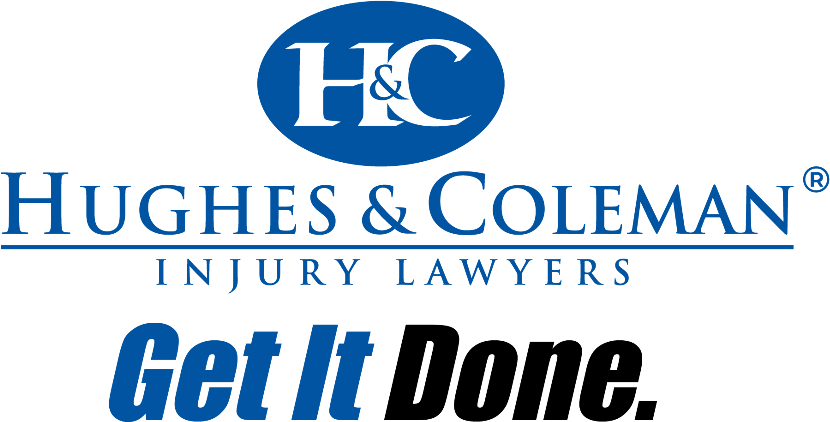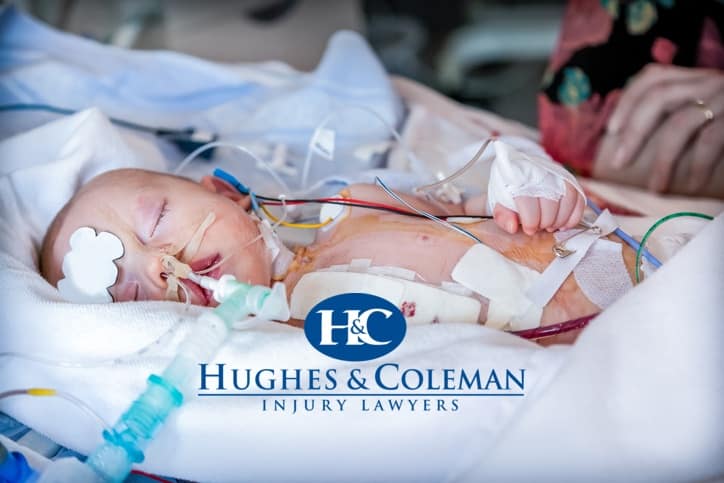-

For nearly 30 years, the Juvenile Products Manufacturers Association (JPMA) has designated September as Baby Safety Month.
Hughes and Coleman Lawyers feel deeply about baby safety. Therefore, in honor of Baby Safety Month, we’ve dedicated our month’s blogs to the topic.
So far we’ve covered general baby and product safety.
While those blogs focused on the moments after birth, this week’s blog covers the moments leading up to birth.
From the instant a couple discovers that they are pregnant, even amidst all the happiness, there can also be an overwhelming fear about the future safety of the baby.
Unfortunately, it’s not unfounded.
Of every 1,000 infants born in Kentucky and Tennessee, the Centers for Disease Control and Prevention (CDC) says six to eight of them are born with a birth injury.
That’s thousands of injuries to newborns right at the moment they enter the world, and this revelation can be devastating to parents who are already planning their child’s future.
Another CDC study found that in 2006 more than 2 million infants had significant birth injuries from just 19 reporting states with issues including skeletal fractures, soft tissue and solid organ hemorrhage, and peripheral nerve damage.
Yet, many injuries are avoidable.
“Close to 50% of all birth injuries are potentially avoidable by identification and planning for obstetrical risk factors,” says Birth Injury Guide, an advocacy group based out of Houston.
Steps to Prevent Birth Injuries
Fortunately, there are steps parents can take to reduce the chance of a birth injury occurring. Gathering as much information as possible can help parents to make the right choices.
What is a Birth Injury and How Does it Happen?
The majority of responsibility for the safe delivery of a newborn rests with the medical staff.
“Doctors, nurses, and other medical staff are expected to know the complexities of prenatal, intrapartum, and peripartum care, but birth injuries can happen despite their knowledge,” says Birth Injury Guide.
Stanford Children’s Health, a division of Stanford Medical, advises that many things – some of them unexpected complications – can cause injuries
“Occasionally during the birth process, the baby may suffer a physical injury that is simply the result of being born. This is sometimes called birth trauma or birth injury,” they said.
Complications ranging from the size of the fetus to the health of the mother can play a role.
However, in a situation of neglect by the medical staff, birth injuries can often involve
- Failure to properly monitor the baby during labor and delivery
- Failure to recognize the need for a cesarean section or delay in performing it
- Failure to deliver the baby in a timely manner
- Failure to detect or prevent hypoxia or asphyxia
- Failure to diagnose birth defects that could have been treated in utero
- Failure to recognize a medical condition of the mother that can affect the baby, such as infection or high blood pressure
- Failure to properly and quickly deliver a baby who is stuck in the birth canal
- Failure to recognize an ectopic pregnancy
- Mishandling of the baby during delivery
- Administering the wrong medication or dosage during pregnancy, labor, or delivery
Steps Parents Can Take to Prevent Birth Injury
When expectant parents go to the hospital for delivery, they have every right to expect that the medical staff is both capable and prepared for what’s to come next. So, while the majority of the responsibility lies with the medical staff, there are some proactive steps parents can take to reduce the chance of birth injury.
“Labor and delivery are scary enough without worrying about preventable birth injuries. Be proactive to decrease the odds of any complications and increase the likelihood of a safe delivery,” said Safe Birth Project, an advocacy group dedicated to successful pregnancies and births.
Seek Prenatal Care Early –
It’s important that doctors are involved as soon as possible in the pregnancy so that they can prescribe vitamins, exercise, and track the health of the baby and mother.
“Make sure you’re honest with your doctor about all of your health conditions and risks and ask questions about what that might mean for your pregnancy or delivery,” advises Safe Birth Project.
The CDC also advises mothers to “be sure to see her doctor when planning a pregnancy and start prenatal care as soon as she thinks that she is pregnant.” This should continue throughout the duration of the pregnancy.
Avoid Harmful Substances –
Alcohol, cigarettes, street drugs, and prescription medications can cause birth complications.
“For many medications taken by pregnant women, the safety has been difficult to determine. Despite the limited safety data, some medications are needed to treat serious conditions,” the CDC said. “If a woman is pregnant or planning a pregnancy, she should not stop taking medications she needs nor begin taking new medications without first talking with her healthcare provider. This includes prescription and over-the-counter medications and dietary or herbal products.”
Address Any Concerns with Prenatal Staff –
During the entire process, it’s important that the medical staff know what to expect given the mother’s and baby’s health. Health issues such as diabetes can cause issues at birth.
“Always contact your prenatal care provider if you have any concerns during your pregnancy,” said the CDC.
Choose Where to Have the Baby –
This is especially the case if parents intend to use a midwife instead of a doctor or have a doctor chosen to deliver the baby that will differ from the hospital staff.
“Sometimes parents want to avoid the mistreatment of a hospital’s staff and elect to have their baby at home. However, having a midwife assist in delivery does not guarantee that the child will not experience a birth injury,” warns Birth Injury Guide.
“In fact, most midwives are not trained medically and if something goes wrong, you are at the mercy of 911 and an ambulance driver. Just as any mother can experience malpractice for her baby, any professional lending delivery services can make the mistakes that qualify as malpractice.”
Be Vocal During Delivery
During the delivery, tell medical staff anything that doesn’t feel right as soon as possible.
“Even a headache or a tingling in your toes could be a sign of a serious complication,” said Safe Birth Project. “You know your body better than anyone — trust your intuition if you think something is wrong. You should also ask questions about any treatments or procedures your healthcare team wants to perform during your delivery.”
The Difference Between Birth Defect and Birth Injury
The above steps will also help prevent birth defects. Defects, though, are different from birth injury.
Birth defects are issues with the baby prior to birth. CDC studies find that 120,000 babies are affected by birth defects each year, which is about one every 4.5 minutes. Defects are issues such as a cleft lip, heart defects or hearing loss and are often identified by a doctor prior to the birth.
Birth Injury is when the newborn is injured as a direct result of the birthing process. According to the Agency for Healthcare Research and Quality, approximately 28,000 infants suffer birth injuries every year in the US.
These are most often caused by medical negligence or malpractice. They can result in Cerebral Palsy, Erb’s Palsy, Head Injury, Traumatic brain injury, paralysis, and death.
Sometimes, complications at birth can cause the medical staff to choose an unsafe method for delivery – such as using forceps, which the Mayo Health Clinic warns “poses a risk of injury for both mother and baby.”
“In a forceps delivery, a health care provider applies forceps — an instrument shaped like a pair of large spoons or salad tongs — to the baby’s head to help guide the baby out of the birth canal. This is typically done during a contraction while the mother pushes,” Mayo Health Clinic said.
Also, whereas birth defects are often tracked and treated either before birth or immediately thereafter, the results of birth injuries can take years to develop.
“In other cases, the effects of a birth injury may not be noticeable until developmental disabilities arise, such as an inability to sit up, or missing developmental growth stages like crawling, walking, talking, or eating independently,” said Birth Injury Guide.
If A Birth Injury Occurs
If it does happen, many parents will find themselves angry at medical personnel and upset over the loss of their child’s future as a result of the injury. They may also need to take on more medical care to care for the permanent effects of the injury.
If parents think that something is wrong with their baby, they should seek medical help as soon as possible. Therapy, surgery, or medication may be able to help.
If the baby’s injuries are as a result of negligence or carelessness by medical staff, parents should discuss their concerns with a birth injury attorney. Damages may be recovered that can help parents care for the costs of caring for the additional medical needs of the child as they grow up.
Depending on the case, they may be able to recover the following damages:
- Future medical care
- Past medical care
- Loss of future earnings
- Pain and suffering
- Punitive damages
While no amount of compensation can make up for the injuries the child has sustained, it can help provide the necessary medical treatment and care the child deserves to live a safe and fulfilling life.
As we continue through Baby Safety Month, Hughes and Coleman Injury Lawyers hope that this is something parents and their children don’t need to experience.
May all parents continue to look forward to the exciting times ahead of them with their newborn.
“Pregnancy is an exciting time, but it also can be stressful,” the CDC said. “Knowing that you are doing all that you can to get ready for pregnancy, staying healthy during pregnancy, and giving your baby a healthy start in life will help you to have peace of mind.”
Further Reading
To reduce stress and anxiety post-birth, parents should be ready for multiple visits to the doctors, with some experts saying to expect at least 9 exams over the first three years.
What to Expect at your Babies First Doctor’s Appointment
Get In Touch Today!
We offer free consultations 24/7 and there will always be someone here to take your call. Call our personal injury lawyers today for a free consultation or fill out this form and we will contact you.
We serve clients across Tennessee and Kentucky and we have several offices throughout both states. See all of our locations and contact us today.


